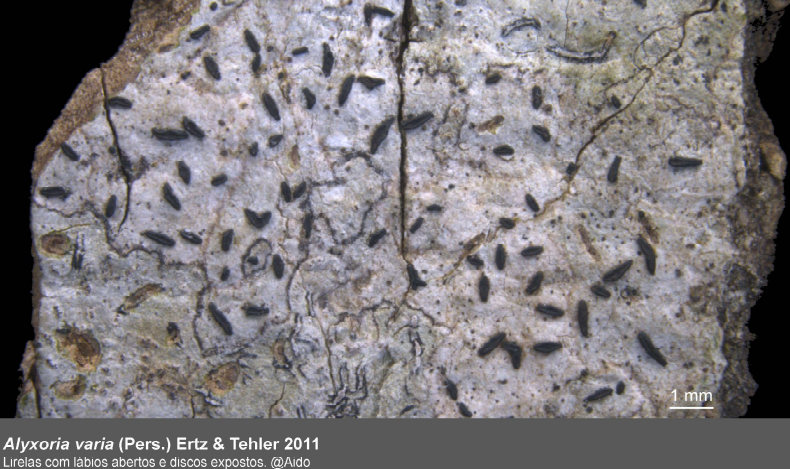Liquens do Miranda, Pantanal: uma investigação das espécies liquênicas dos capões
DOI:
https://doi.org/10.37002/biodiversidadebrasileira.v14i4.2564Palavras-chave:
Fungos liquenizados, Ascomycota, taxonomiaResumo
Este estudo expõe a diversidade da funga liquênica da região do Miranda, Pantanal Sul-mato-grossense. A metodologia amostrou o máximo de morfotipos de liquens epifíticos presentes em cada ponto, abrangendo um total de 25 áreas amostradas. Os espécimes foram coletados entre 50 cm a 170 cm de altura. Foram encontrados 48 gêneros e 84 espécies de liquens. As espécies mais abundantes são: Alyxoria varia, Bacidina medialis, Glyphis cicatricosa, Glyphis scyphulifera, Graphis caesiella, Graphis lineola, Lecanora leprosa, Opegrapha astraea, Opegrapha cylindrica, Pertusaria flavens e Trypethelium eluteriae. Os gêneros com maior número de espécies presentes são Graphis (11 espécies) e Pyrenula (9 espécies). Os liquens com hábito de crescimento crostoso são os mais comuns na região amostrada.
Downloads
Referências
1. Honegger R. The Lichen Symbiosis – What is so Spectacular about it? Lichenologist [Internet]. Maio 1998 [citado 5 mar 2024]; 30(3): 193-212. Disponível em: https://doi.org/10.1006/lich.1998.0140.
2. Hawksworth DL. The variety of fungal-algal symbioses, their evolutionary significance, and the nature of lichens. Bot J Linn Soc [Internet]. Jan 1988 [citado 5 mar 2024]; 96(1): 3-20. Disponível em: https://doi.org/10.1111/j.1095-8339.1988.tb00623.x.
3. Honegger R. Functional Aspects of the Lichen Symbiosis. Annu Rev Plant Physiol Plant Mol Biol [Internet]. Jun 1991 [citado 5 mar 2024]; 42(1): 553-78. Disponível em: https://doi.org/10.1146/annurev.pp.42.060191.003005.
4. Pennisi E. A lichen menage a trois. Science [Internet]. 21 jul 2016 [citado 5 mar 2024]; 353(6297): 337. Disponível em: https://doi.org/10.1126/science.353.6297.337.
5. Spribille T, Tuovinen V, Resl P, Vanderpool D, Wolinski H, Aime MC, Schneider K, Stabentheiner E, Toome-Heller M, Thor G, Mayrhofer H, Johannesson H, McCutcheon JP. Basidiomycete yeasts in the cortex of ascomycete macrolichens. Science [Internet]. 21 jul 2016 [citado 5 mar 2024]; 353(6298): 488-92. Disponível em: https://doi.org/10.1126/science.aaf8287.
6. Tuovinen V, Ekman S, Thor G, Vanderpool D, Spribille T, Johannesson H. Two Basidiomycete Fungi in the Cortex of Wolf Lichens. Curr Biol [Internet]. Fev 2019 [citado 5 mar 2024]; 29(3): 476-83. Disponível em: https://doi.org/10.1016/j.cub.2018.12.022.
7. Richardson DH. War in the world of lichens: parasitism and symbiosis as exemplified by lichens and lichenicolous fungi. Mycol Res [Internet]. Jun 1999 [citado 5 mar 2024]; 103(6):641-50. Disponível em: https://doi.org/10.1017/s0953756298008259.
8. Hawksworth DL, Grube M. Lichens redefined as complex ecosystems. New Phytol [Internet]. 2 jun 2020 [citado 5 mar 2024]; 227(5): 1281-3. Disponível em: https://doi.org/10.1111/nph.16630.
9. Grimm M, Grube M, Schiefelbein U, Zühlke D, Bernhardt J, Riedel K. The Lichens Microbiota, Still a Mystery? Front Microbiol [Internet]. 30 mar 2021 [citado 5 mar 2024]; 12. Disponível em: https://doi.org/10.3389/fmicb.2021.623839.
10. Torres JM, Aptroot A, Spielmann A. Microliquens no Chaco Brasileiro. Em: Chaco: Caracterização, riqueza, diversidade, recursos einterações [Internet]. Campo Grande: Editora UFMS; 2021. p. 190-222. Available from: https://www.researchgate.net/profile/Angela-Sartori/publication/357127398_Chaco_-_Caracterizacao_riqueza_diversidade_recursos_e_interacoes_1/links/61bca67963bbd932429daa0e/Chaco-Caracterizacao-riqueza-diversidade-recursos-e-interacoes-1.pdf
11. Canêz LS, Koch NM; Barbosa TD, Kitaura MJ, Spielmann AA, Honda NK, Jungbluth P, Gerlach A, Lücking R, Aptroot A. Lichenized Ascomycota from the Pantanal in Mato Grosso do Sul state, Brazil. In: Damasceno-Junior GA, Pott A. (eds.). Flora and Vegetation of the Pantanal Wetland. Plant and Vegetation 18. 2022; 1ed., 1: 315-363. Doi: https://doi.org/10.1007/978-3-030-83375-6_6.
12. Aptroot A, Fernanda de Souza Silva M, Spielmann A. New lichens of the Pantanal in Brazil New lichen species from the Pantanal in Mato Grosso do Sul, Brazil [Internet]. Disponível em: https://publikationen.ub.uni-frankfurt.de/opus4/frontdoor/deliver/index/docId/59140/file/vol20_aptroot_et_al_2020_pantanal.pdf
13. Asplund J, Wardle DA. How lichens impact on terrestrial community and ecosystem properties. Biol Rev [Internet]. 11 out 2016 [citado 5 mar 2024]; 92(3): 1720-38. Disponível em: https://doi.org/10.1111/brv.12305.
14. Galloway DJ. Lichen biogeography. Em: Nash TH, editor. Lichen Biology [Internet]. Cambridge: Cambridge University Press; [citado 5 mar 2024]. p. 315-35. Disponível em: https://doi.org/10.1017/cbo9780511790478.017.
15. Feuerer T, Hawksworth DL. Biodiversity of lichens, including a world-wide analysis of checklist data based on Takhtajan’s floristic regions. Biodivers Conserv [Internet]. Jan 2007 [citado 5 mar 2024]; 16(1): 85-98. Disponível em: https://doi.org/10.1007/s10531-006-9142-6.
16. Mioto CL, Filho ACP, Albrez EA. Contribuição à caracterização das sub-regiões do Pantanal. ENTRE-LUGAR. 2012; 3(6): 165-180. Recuperado de https://ojs.ufgd.edu.br/index.php/entre-lugar/article/view/2453.
17. Embrapa Florestas - Portal Embrapa [Internet]. Clima; [citado 5 mar 2024]. Disponível em: https://www.cnpf.embrapa.br/pesquisa/efb/clima.htm.
18. Soriano BMA. Caracterizacao climatica de Corumba-MS. wwwinfotecacnptiaembrapabr [Internet]. 1997 [citado 2024 Mar 5]; Available from: http://www.infoteca.cnptia.embrapa.br/infoteca/handle/doc/792188.
19. Adámoli J. A dinâmica das inundações no Pantanal. Anais do I Simpósio sobre Recursos Naturais e Socioeconômicos do Pantanal. CPAP Embrapa, Corumbá; 1986. 51-62.
20. Pott A, Oliveira A, Damasceno-Junior G, Silva J. Plant diversity of the Pantanal wetland. Braz J Biol [Internet]. Abr 2011 [citado 5 mar 2024]; 71(1 suppl 1): 265-73. Disponível em: https://doi.org/10.1590/s1519-69842011000200005.
21. Damasceno-Junior GA, Semir J, Antonio Maës dos Santos F, de Freitas Leitão-Filho H. Structure, distribution of species and inundation in a riparian forest of Rio Paraguai, Pantanal, Brazil. Flora Morphol Distrib Funct Ecol Plants [Internet]. Maio 2005 [citado 5 mar 2024]; 200(2): 119-35. Disponível em: https://doi.org/10.1016/j.flora.2004.09.002.
22. Araujo AC de. Flora, fenologia de floração e polinização em capões do Pantanal Sul-Mato-Grossense [Tese]. [Universidade Estadual de Campinas]; 2001. 1-109.
23. Filgueiras T de S, Brochado AL, Nogueira PE, Guala G. Caminhamento - um método expedito para levantamentos florísticos qualitativos. Em: Cadernos de Geociências. Rio de Janeiro: Fundação Instituto Brasileiro e Geografia e Estatística; 1994. 39-43.
24. Fink B. How to Collect and Study Lichens. Bryologist [Internet]. Mar 1905 [citado 5 mar 2024]; 8(2) :22. Disponível em: https://doi.org/10.2307/3237900.
25. Nayaka S. Plant taxonomy and biosystematics - Classical and modern methods. New Delhi: New India Publishing Agency; 2014. Methods and techniques in collection, preservation and identification of lichens; p. 101-28.
26. Hale ME. Lichen handbook: A guide to the lichens of eastern North America. [local desconhecido]: Smithsonian Institution; 1968. 178 p.
27. Orange A, James TD, White FJ. Microchemical Methods for the Identification of Lichens. British Lichen Society; 2001; p101.
28. Aptroot A, Barbosa TD, Benatti MN, Canêz LS, Cáceres MES, Dal Forno M, Gerlach A, Gumboski E, Honda NK, Käffer MI, Kitaura MJ, Koch NM, Lücking R, Jungbluth P, Torres JM, Spielmann AA. Brazilian Lichen Guide. In prep.a.
29. Aptroot A, Alves dos Santos L, Benatti MN, Cáceres Canêz LS, Dal Forno M, Feuerstein SC, Fraga Junior CAV, Gerlach ACL, Gumboski EL, Jungbluth P, Käffer M, Kalb K, Koch NM, Lücking R, Torres JM, Spielmann AA. The Brazilian lichen checklist: 4,879 accepted taxa constitute a country-level world record. The Bryologist. In prep.b.
30. Arup U, Søchting U, Frödén P. A new taxonomy of the family Teloschistaceae. Nord J Bot [Internet]. Fev 2013 [citado 5 mar 2024]; 31(1): 016-83. Disponível em: https://doi.org/10.1111/j.1756-1051.2013.00062.x.
31. Kalb K, Staiger B, Elix JA. A monograph of the lichen genus Diorygma–a first attempt. Symbolae Botanicae Upsalienses, 2004; 34(1): 133-181.
32. Barbosa TD. Caliciaceae foliosas em Mato Grosso do Sul, Brasil [Internet] [Dissertação]. Spielmann AA, Jungbluth P, Aptroot A (eds.). [Universidade Federal de Mato Grosso do Sul]; 2019 [cited 2024 Apr 5]. p. 270. Disponível em: https://ppgbiovegetal.ufms.br/files/2021/08/Barbosa_Dissertacao_Texto-Final-1-1.pdf.
33. Cáceres MES, Aptroot A, Parnmen S, Lücking R. Remarkable diversity of the lichen family Graphidaceae in the Amazon rain forest of Rondônia, Brazil. Phytotaxa. 2014; 189: 87–136-87–136. doi:10.11646/phytotaxa.189.1.8
34. Mercado-díaz JA, Lücking R, Parnmen S. Two new genera and twelve new species of Graphidaceae from Puerto Rico: a case for higher endemism of lichenized fungi in islands of the Caribbean? Phytotaxa [Internet]. 19 dez 2014 [citado 6 mar 2024]; 189(1): 186. Disponível em: https://doi.org/10.11646/phytotaxa.189.1.14.
35. Lücking R, Archer AW, Aptroot AA. World-wide key to the genus Graphis (Ostropales: Graphidaceae). Lichenologist [Internet]. Jul 2009 [citado 6 mar 2024]; 41(4): 363-452. Disponível em: https://doi.org/10.1017/s0024282909008305.
36. Kitaura MJ. Estudo taxonômico de Leptogium (ACH.) S.F. Gray (Collemataceae, fungos liquenizados) [tese]. [Universidade Estadual Paulista (Unesp)]; 2012; p. 15-267.
37. Jungbluth P. A família Parmeliaceae (fungos liquenizados) em fragmentos de cerrados do Estado de São Paulo [internet] [dissertação]. [Instituto de Botânica da Secretaria de Estado do Meio Ambiente]; 2006 [cited 2024 Apr 5]. Available from: https://smastr16.blob.core.windows.net/pgibt/2013/09/Patricia_Jungbluth_MS.pdf.
38. Cáceres ME. Corticolous crustose and microfoliose lichens of northeastern Brazil (Libri Botanici). [local desconhecido]: IHW Verlag; 2007. 168 p.
39. Benatti MN, Marcelli MP. Physciaceae foliosas do Parque Estadual da Cantareira, estado de São Paulo. III. Espécies do Gênero Physcia. Rodriguésia, 70, 2019. https://doi.org/10.1590/2175-7860201970061.
40. Sérusiaux E, Berger F, Brand M, van den Boom P. The lichen genus Porina in Macaronesia, with descriptions of two new species. Lichenologist [Internet]. 22 dez 2006 [citado 6 mar 2024]; 39(1): 15-33. Disponível em: https://doi.org/10.1017/s0024282907005993.
41. Cáceres ME, Santos MW, Mendonça CD, Mota DA, Aptroot A. New lichen species of the genera Porina and Byssoloma from an urban Atlantic rainforest patch in Sergipe, NE Brazil. Lichenologist [Internet]. Maio 2013 [citado 6 mar 2024]; 45(3): 379-82. Disponível em: https://doi.org/10.1017/s0024282913000054.
42. Sparrius LB. Biodiversity and Ecology of Lichens. [local desconhecido]: Bibliotheca Lichenologica 99; 2009. Synarthothelium, a new genus in the Arthoniaceae with a thalline exciple, similar to Synarthonia. p. 373-82.
43. Aptroot A. The lichen genus Traponora. Diversity of Lichenology - Anniversary Volume. 100a ed. Bibliotheca Lichenologica; 2009.
44. Luangsuphabool T, Piapukiew J, Parnmen S, Nelsen MP, Lumbsch HT, Sangvichien E. Diversity of the Trypethelium eluteriae group in Thailand (Ascomycota, Trypetheliales). Lichenologist [Internet]. Jan 2016 [citado 6 mar 2024]; 48(1): 53-60. Disponível em: https://doi.org/10.1017/s0024282915000444.
45. Aptroot A, Lücking R. A revisionary synopsis of the Trypetheliaceae (Ascomycota: Trypetheliales). The Lichenologist. 2016; 48(6): 763-982. doi:10.1017/S0024282916000487.
46. Fleig M, Riquelme I. Líquens de Piraputanga, Mato Grosso do Sul, Brasil. Acta Botanica Brasilica. 1991 Jul 1; 5(1): 03-12. Disponível em: https://doi.org/10.1590/S0102-33061991000100001
47. Natália Mossmann Koch, Maria, Fabiane Lucheta, Sandra Cristina Müller. Functional diversity and traits assembly patterns of lichens as indicators of successional stages in a tropical rainforest. Ecological Indicators. 2013 Nov 1; 34: 22-30.
48. Passos P de O. Padrão de distribuição dos liquens em unidades de paisagem do Domínio Atlântico Sergipano. [Dissertação]. [Universidade Federal de Sergipe]; 2022. p. 1-82.

Downloads
Publicado
Edição
Seção
Licença
Copyright (c) 2024 Os autores mantêm os direitos autorais de seus artigos sem restrições, concedendo ao editor direitos de publicação não exclusivos.

Este trabalho está licenciado sob uma licença Creative Commons Attribution-NonCommercial-NoDerivatives 4.0 International License.
Os artigos estão licenciados sob uma licença Creative Commons Atribuição-NãoComercial-SemDerivações 4.0 Internacional (CC BY-NC-ND 4.0). O acesso é livre e gratuito para download e leitura, ou seja, é permitido copiar e redistribuir o material em qualquer mídia ou formato.










